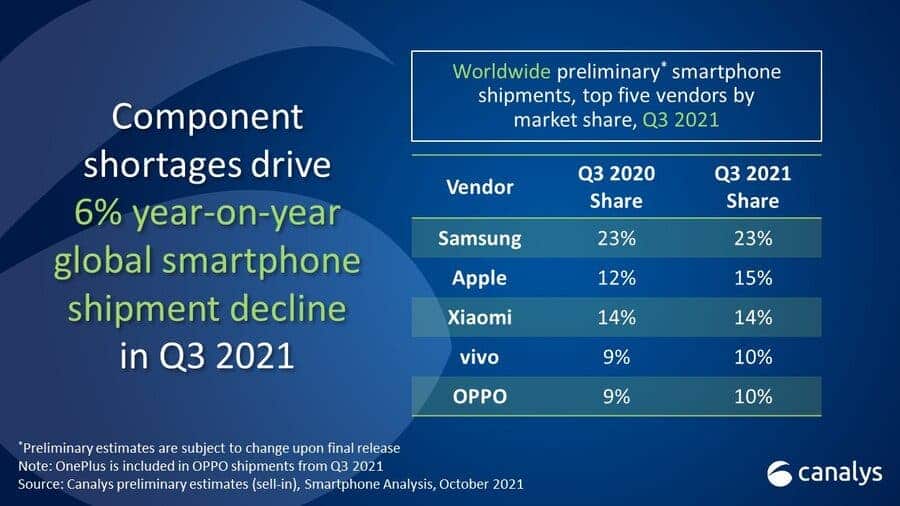Summing up the results of 2020, the words pandemic and shortage invariably sounded, which negatively affected the electronics market and especially the smartphones market. With the onset of 2021, many believed in the best that the situation could be normalized in the near future. And the first months of this year inspired optimism, and it seemed that the worst times were behind us and the electronics market expects only growth.
But, alas, the deficit continued to dictate terms. It influenced the production of devices and their cost. After analyzing the situation in the smartphone market in the third quarter of this year, Canalys analysts concluded that device shipments decreased by 6% year on year. The shortage of components is the reason.
Number one continues to be Samsung, which controls 23% of the mobile market. The company showed exactly the same result a year earlier. In second place was Apple, whose share was 15%, which is 3% more than in the same period last year. Stability is also demonstrated by Xiaomi, which again occupies 14% of the smartphone market, as in the previous year.
Fourth and fifth places went to Vivo and Oppo with 10% market share versus 9% in the third quarter of last year. In total, in the third quarter of this year, 327 million units were delivered to the market, while a year earlier this figure was 348 million units. Analysts predict that generous discounts and big sales should not be expected during the holiday season. There are not enough devices and there are no guarantees that warehouse stocks will soon get new items so as to cover all demand.

Global smartphone market shrinks 6% amid component shortages
“The chipset famine has truly arrived,” said Canalys Principal Analyst, Ben Stanton. “The smartphone industry is striving to maximize production of devices as best it can. On the supply side, chipset manufacturers are increasing prices to disincentivize over-ordering; in an attempt to close the gap between demand and supply. But despite this, shortages will not ease until well into 2022. As a result of this, as well as high costs of global freight; smartphone brands have reluctantly pushed up device retail pricing.”
“At the local level, smartphone vendors are also having to implement last-minute changes in device specification and order quantities. It is critical for them to do this and maximize volume capacity; but unfortunately it does lead to confusion and inefficiency when communicating with retail and distributor channels,” continued Stanton. “Many channels are nervous heading into important sales holidays; such as Singles’ Day in China, and Black Friday in the west. Channel inventories of smartphones are already running low; and as more customers start to anticipate these sales cycles, the impending wave of demand will be impossible to fulfill. Customers should expect smartphone discounting this year to be less aggressive. But to avoid customer disappointment, smartphone brands which are constrained on margin should look to bundle other devices, such as wearables and IoT, to create good incentives for customers.”





